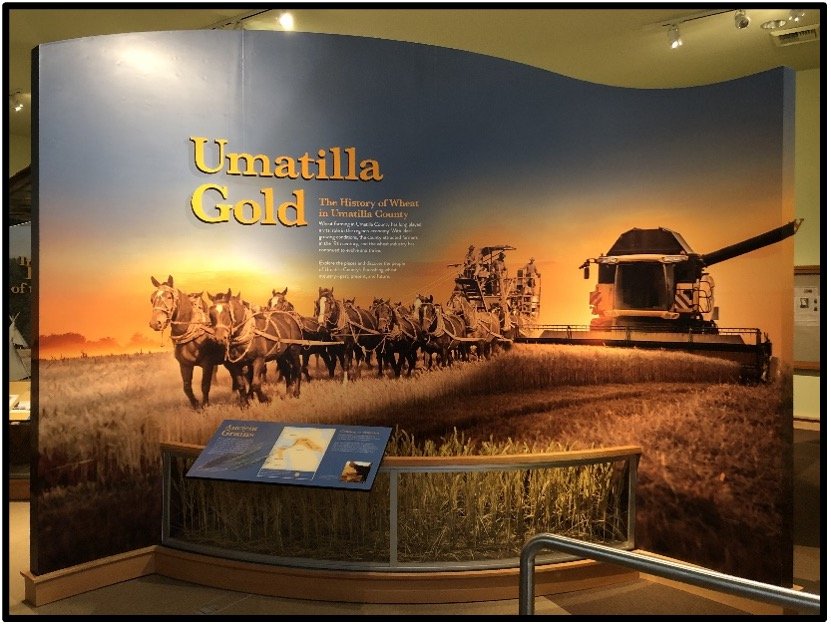“Save the best for last,” the saying goes, and what a pleasant surprise to find on the last day of our cross-country expedition one of the finest agricultural exhibits we had seen anywhere in the country. Pendleton, Oregon, is best known for the annual “Stampede” rodeo held there for over a century. But grain has been grown in the area far longer—reaching back to nineteenth century Hudson Bay Company trader days. The remarkable story of the region’s agricultural heritage is the subject an impressive new exhibit at the city’s Umatialla County Historical Society’s Heritage Station Museum where we were hosted by tour coordinator Shannon Gruenhagen.
The museum’s substantial “Umatilla Gold” exhibit showcases numerous aspects of grain production with special emphasis on agricultural innovations. But among the featured treasures is the remarkable art of Portland artist brothers Arthur (1891-1971) and Albert (1894-1971) Runquist. They both attended the Art Students League in New York in the early Thirties and returned to the Northwest where they shared a studio and painted scenes laden with social commentary on the experiences of minorities and laborers. Arthur, who began working for the Federal Arts Program in 1935, was once severely beaten for his socialist leanings. He painted numerous landscapes including the richly colored Early Oregon (1941) mural as a state Federal Arts Program commission for Pendleton High School on which he was assisted by the brothers’ “self-described sister” and fellow activist Martina Gangle (1906-1994). The immense painting includes a substantial harvest scene that shows unsmiling field hands resting amidst the stubble in the foreground of a passing threshing machine while other workers stack grain sacks on a truck. A red elevator rises in the distance against a range of barren hills and the pensive pose of the central figure casts a mood of resilience amidst despair upon the idyllic landscape. The harvest scene, now framed in three panels with other sections of the mural, were salvaged during renovation at the school for exhibition at the Pendleton museum.
Although still in the throes of the Great Depression, most Northwest farmers had long since made the transition to mechanized farming. Only one large farm along the lower Columbia River route as late as the 1940s still used animal power to pull the combine behemoths. George Wagenblast of Dufur, Oregon, harvested rugged slopes near the mouth of the Deschutes and could not bear to part with his beloved team of twenty-seven mules. But times were changing and in 1941 they would make their last appearance before being sold for wartime service by the U. S. Army for about $45 a head. (He had paid $175 apiece in 1929). Comparing New Deal era and twenty-first-century themes in public art and critical discourse indicates a modern trend away from intellectual consideration of the land and its toiling masses who feed the world. Of over 45,000 entries in the most recent edition of the authoritative thirty-four-volume Grove Encyclopedia of Art (2011), for example, no subject headings are included for agrarian, agriculture, rural, or rustic.
Arthur Runquist, Early Oregon Harvest Panels (1941)
New Deal Art Project Mural, Pendleton, Oregon, High School
Relocated to the Umatilla County Historical Society Museum, Pendleton
“Umatilla Gold” Exhibit Panel
To be sure, countless numbers of regional artists and authors continue to create important interpretive works. Their enduring appeal is evident in the listings of agency websites like Saatchi Art and Mutual Art that feature hundreds of contemporary harvest-themed works and in exhibits like we found in Pendleton. Israeli historian Yuval Harari, author of Homo Deus: A Brief History of Tomorrow (2015), suggests that the pace of technological innovation is increasingly associated with the volume of personalized digital postings that threaten shared values that have long knit cultural identities and connected peoples to landscapes. Such preoccupation, Harari asserts, not only increasingly distances people from employable skills, but risks humanity’s wellbeing by neglecting regard for land care and sustaining social values. Hats off to the dedicated folks who affirm timeless agrarian values in places we visited this summer like Mt. Vernon and Steele’s Tavern, Virginia; the Spanish colonial missions from Texas to Arizona, Springville, Utah; Aberdeen, Idaho; and Pendleton, Oregon. Washington (D. C.) to Washington …nice to be back home!




